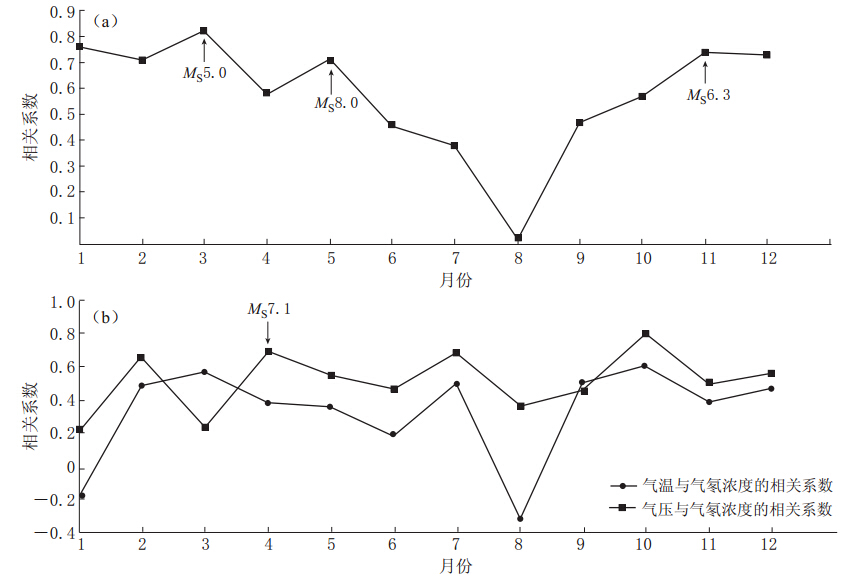Correlativity between short-term change of fault gas radon concentration and air temperature & atmospheric pressure
-
摘要: 以嘉峪关断层气氡为研究对象, 利用气氡和气温、 气压的日值, 通过计算气温气压与气氡浓度的相关系数, 分析了气温和气压对断层气氡浓度短期变化的影响. 结果显示, 气温和气压对气氡浓度的短期影响显著, 其表现为既具有相似性特征, 又存在明显的差别: ① 在对气氡浓度的影响程度上, 气压明显大于气温. ② 气温和气压对气氡浓度的影响均具有明显的滞后效应, 如离取样时间最近的0—8时, 它们对气氡浓度的影响均逐渐减弱, 但气温对气氡浓度的影响于7时达到最低, 8时仍在低位变化; 而气压对气氡浓度的影响则在8时达到最低值. 9时气温和气压的影响都出现快速上升, 之后气压对气氡浓度的影响表现为波动缓慢上升变化, 18—19时达到最高值; 9时之后气温对气氡浓度的影响则表现为波动缓慢下降变化. ③ 不同月份气压和气温对气氡浓度的影响也存在明显的差异. 气压的影响具有很好的规律性, 1—4月为高影响状态, 5月份开始出现快速下降变化, 8月份达到最低值, 9月份略有回返, 10—12月又达到了全年的最高值; 而气温对气氡浓度的影响除3月份和4月份比较高之外, 其它月份都在低值变化, 并且差别不大. ④ 对震例的分析结果表明, 嘉峪关气氡浓度大幅正突跳变化不具备预报地震的能力.Abstract: Using daily values of gas radon concentration from Jiayuguan fault as well as daily values of air temperature and atmospheric pressure in Jiayuguan, this paper studied the influence of air temperature and atmospheric pressure on short-term change of gas radon concentration by calculating the correlation coefficient between air temperature & atmospheric pressure and gas radon concentration. The results showed that both air temperature and atmospheric pressure had obvious influence on short-term change of gas radon concentration. ① The influence from atmospheric pressure is more remarkable than that from air temperature. ② The influences of air temperature and atmospheric pressure both had time-lag characteristic. At 0—8 o’clock, their influences on radon concentration were gradually weakened. The influence of air temperature was the weakest at 7 and 8 o’clock in a day, but the influence of atmospheric pressure was the weakest only at 8 o’clock in a day. At 9 o’clock, their influences were rapidly increasing. Since then, the influence of atmospheric pressure became slower growth and it was up to the strongest at 18 o’clock in a day, but the influence of air temperature became slow down. ③ There were significant differences in influences of air temperature and atmospheric pressure in different months. The influence of atmospheric pressure had good laws such as it was on high level state from January to April and started to decline from May and reached the lowest in August, and then, it rose and reached highest level in October, and it was at a high level. The influence of air temperature had no obvious laws and their monthly frequency values were all low. ④ The analyses on related earthquakes indicated that the short-term sharp changes of gas radon concentration had no ability to forecast earthquake.
-
-
图 1 气温气压与气氡浓度达到相关的月频次图
Figure 1. The monthly frequencies of air temperature and pressure correlating with gas radon concentration where the curve with dots denote the frequency of air temperature correlating with gas radon concentration, and the curve with squares denotes the frequency of atmospheric pressure correlating with gas radon concentration
图 3 (a) 2008年气压与气氡浓度的相关系数; (b) 2010年气温和气压与气氡浓度的相关系数
Figure 3. (a) The correlation coefficent between air pressure and gas radon concentration in 2008; (b) The correlation coefficent between air temperature & pressure and gas radon concentration in 2010 where the curve with dots denote the correlation coefficient between air temperature and gas radon concentration, and the curve with squares denotes that between pressure and gas radon concentration
表 1 地震参数及相应气氡浓度突变时间表
Table 1 Parameters of the earthquakes occurred in Qilianshan in 2005—2013 and corrsponding sudden change times of gas radon concentration before the earthquakes

表 2 中强及以上地震前去掉气氡浓度突跳点前后气温气压与气氡浓度相关系数变化表
Table 2 The correlation coefficient between air temperature & pressure and radon concentration before MS≥5.0 earthquakes before and after deleting the sudden change points of gas randon concentration

-
曹喜, 张占斌, 张彩艳. 2008. 嘉峪关断层气氡对祁连山西段中强地震的异常特征分析[J] . 地震地磁观测与研究, 29(1): 50-53. Cao X, Zhang Z B, Zhang C Y. 2008. Analysis on the anomalous characteristics of Jiayuguan gas radon to the strong earthquakes in western segment of Qilian Mountain[J]. Seismological and Geomagnetic Observation and Research, 29(1): 50-53 (in Chinese).
常秋君, 何跟巧, 郭玉英, 宋玉兰, 程天德. 1993. 断层气定点观测主要影响因素的研究[J]. 西北地震学报, 15(4): 82-89. Chang Q J, He G Q, Guo Y Y, Song Y L, Cheng T D. 1993. Study on main influences on fixed-point observation of fault gases[J]. Northwestern Seismological Journal, 15(4): 82-89 (in Chinese).
车用太, 张大维, 鱼金子, 王基华. 1995. 断层带土壤气的映震效能与地震短期预报[J]. 中国地震, 11(4): 374-380. Che Y T, Zhang D W, Yu J Z, Wang J H. 1995. Reflective capacity of soil gas in fault zone to earthquake and short-term prediction[J]. Earthquake Research in China, 11(4): 374-380 (in Chinese).
杜建国, 宇文欣, 李圣强, 简春林, 朱自强, 陈华静, 康春丽. 1998. 八宝山断裂带逸出氡的地球化学特征及其映震效能[J]. 地震, 18(2): 155-162. Du J G, Yuwen X, Li S Q, Jian C L, Zhu Z Q, Chen H J, Kang C L. 1998. The geochemical characteristics of escaped radon from the Babaoshan fault zone and its earthquake reflecting effect[J]. Earthquake, 18(2): 155-162 (in Chinese).
侯彦珍, 王永才, 张根深. 1994. 土壤气氡测量影响因素的初步研究[J]. 华北地震科学, 12(2): 55-59. Hou Y Z, Wang Y C, Zhang G S. 1994. A preliminary study of the influence factor on soil gas radon measurement[J]. North China Earthquake Sciences, 12(2): 55-59 (in Chinese).
李利红, 葛良全, 程锋, 田丽霞, 敬伯科. 2007. 空气中氡浓度时间变化规律探讨[J]. 辐射防护, 27(1): 13-18. Li L H, Ge L Q, Cheng F, Tian L X, Jing B K. 2007. Study on the temporal change of radon concentration[J]. Radiation Protection, 27(1): 13-18 (in Chinese).
刘菁华, 王祝文, 田钢, 王晓丽. 2007. 均匀覆盖层中氡迁移的数值模拟[J]. 地球物理学报, 50(3): 921-925. Liu J H, Wang Z W, Tian G, Wang X L. 2007. Numerical simulation for radon migration in the homogeneous overburden[J]. Chinese Journal of Geophysics, 50(3): 921-925 (in Chinese).
王博, 黄辅琼, 简春林. 2010. 嘉峪关断层带土壤气氡的影响因素及映震效能分析[J]. 中国地震, 26(4): 407-417. Wang B, Huang F Q, Jian C L. 2010. The influencing factors of escaped radon from Jiayuguan station and its earthquake reflecting effect[J]. Earthquake Research in China, 26(4): 407-417 (in Chinese).
朱自强, 简春林, 宇文欣. 1991. 土氡测量影响因素的初步探讨[G]//断层气测量在地震科学中的应用. 北京: 地震出版社: 222-226. Zhu Z Q, Jian C L, Yuwen X. 1991. The preliminary study of the influence factor on soil gas radon measurement[G]//Applications of Fracture Gases Measurement in Seismology. Beijing: Seismological Press: 222-226 (in Chinese).
-
期刊类型引用(5)
1. 俞慧婷,陈宇乔,杨元德,李斐. 南极冰川地震学研究进展. 地球物理学进展. 2022(05): 1875-1884 .  百度学术
百度学术
2. 殷宝玲,刘琪,王叶堂. 1961—2017年南极冰盖近地面风时空变化研究. 冰川冻土. 2021(05): 1383-1399 .  百度学术
百度学术
3. 刘志云,黄川,于晖,钟振涛,崔福庆. 青藏工程走廊活动层厚度预测模型与分布特征研究. 冰川冻土. 2021(05): 1458-1467 .  百度学术
百度学术
4. 牛雄伟,高金耀,吴招才,阮爱国,卫小冬,刘晨光,李天光,沈中延,潘少军,罗孝文. 南极洲普里兹湾岩石圈各向异性:海底地震仪观测. 地球科学. 2016(11): 1950-1958 .  百度学术
百度学术
5. 刘莎,田宝峰,姜旭东,徐志强,郑钰,杨建思. 南极长城站地壳和上地幔各向异性分析. 地震学报. 2014(05): 862-871 .  本站查看
本站查看
其他类型引用(5)





 下载:
下载:


